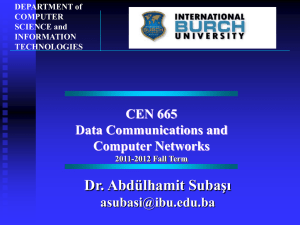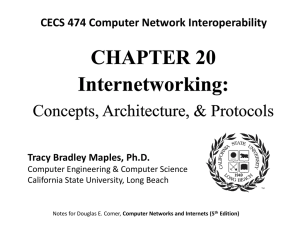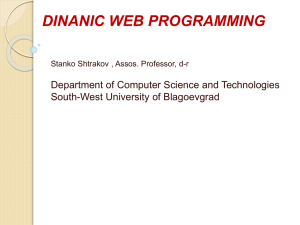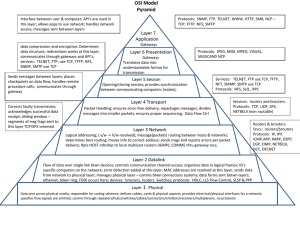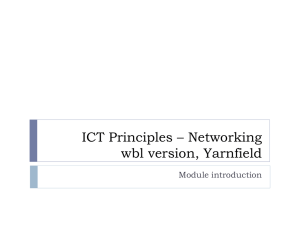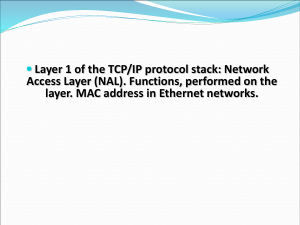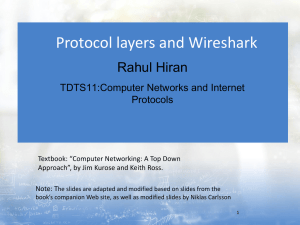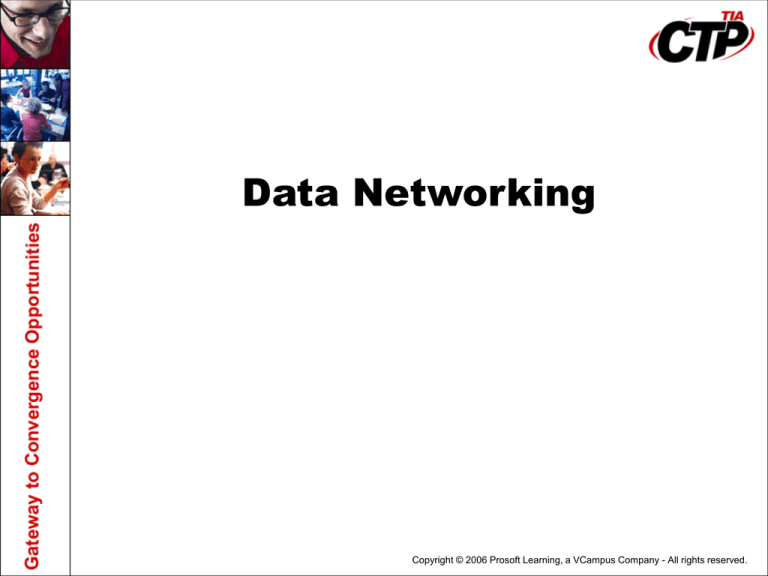
Data Networking
Copyright © 2006 Prosoft Learning, a VCampus Company - All rights reserved.
Lesson 1:
Introduction to Data Networking
Copyright © 2006 Prosoft Learning, a VCampus Company - All rights reserved.
Objectives
•
•
•
•
•
•
Define networking and the concept of convergence
Describe Bluetooth and RFID
Identify networking models
Describe next-generation technologies
Identify network topologies
Define the purpose and function of network
operating systems
• Describe various operating systems
• View operating system error logs
• Describe embedded operating systems
Networks
• A network is two or more connected computers
that share data
• Most data networks utilize the PSTN
• Modems are still widely used
• Voice over IP (VoIP) delivers voice information in
digital form as packets of data
Cell phones
• Modern cell phones are used for much more than
phone calls
– 1G wireless phones were for voice only
– 2G wireless phones were digital
– 3G phones can be used for Web browsing,
multimedia and video conferencing
– Smartphones combine the functionalities of cell
phones and PDAs
SMS
• Short Message Service (SMS) permits the sending
and receiving of short text messages from:
– Mobile to mobile
– Mobile to computer
– Computer to mobile
• Allows you to send messages without incurring
airtime charges
• Some Web sites offer free SMS services, allowing
you to get driving directions, find out when a movie
is playing, or perform currency conversions on
your cell phone
Bluetooth
• Specifies how various electronic devices can be
connected and synchronized using short-range radio
signals
• Creates Personal Area Networks (PANs) between
suitably equipped devices
• The connection and formation of a PAN is automatic
• Bluetooth devices use low-power transmissions in the
2.45 GHz band
• Does not require line of sight; signals can pass through
walls
• Functionality is divided into separate types of
connections known as profiles
• Most implementations are non-secure by default
Radio Frequency Identification (RFID)
• Currently used for tracking cargo shipments and
deliveries, and for automated road toll collection
• Uses tags (microchip and antenna coil) and
readers
• Tags can be passive (no power supply) or active
(includes a battery)
• Advantages: no contact is required between tag
and reader, nor is line of sight; operates well in
poor-visibility conditions
• Disadvantages: raises privacy concerns, and the
technology is expensive
Networking Models and Evolution
• Mainframe: centralized, slow, expensive; all
processing is performed by the mainframe
• Client/server: distributed, reduces congestion by
dividing processing and storage tasks between the
client and the server
• Web-based: three-tier or n-tier networking;
distributed networking that offers speed and
flexibility
• Peer-to-peer: distributed networking that supports
many thousands of simultaneous users to connect
with each other and directly share files on their
hard drives
• Cellular: star-topology in which users within a
given cell must access a base station for
connectivity
Network Topologies
Bus
Star
Ring
Hybrid (star bus)
Centralized Hub
Bus Trunk
Server
Client
Mesh
Server
Client
Network Operating System
•
•
•
•
•
Manages multiple users on a network
Provides access to file and print servers
Provides services such as Web, FTP and e-mail
Implements network security
Part of the NOS must run from the client and part
of it must run from the server
Many major network operating systems can
operate with one another; this feature is called
interoperability
Microsoft Windows Servers
•
•
•
•
•
Windows NT 3.1
Windows NT 3.5
Windows NT 4.0
Windows 2000
Windows Server 2003
Windows XP Professional, Windows 2000
Professional and NT 4.0 workstations are
recommended as clients in secure environments
The Windows superuser account is named
Administrator or Admin
UNIX
• Many versions of UNIX have evolved from the
original kernel
• Superuser account is named root
• UNIX operating systems consist of at least one
kernel, a file system and a shell
• GUIs such as X Window were developed to simplify
UNIX operations
• Flavors of UNIX are based on one of the following
basic platform strategies: System V, Berkeley
Software Distribution (BSD), Open Software
Foundation (OSF)
• Flavors of UNIX include: Linux, Sun Solaris, BSD
Linux
•
•
•
•
Developed by Linus Torvalds
Can operate as a client or as a server
Superuser account is named root
Supports all of the most common Internet
protocols, including TCP/IP, SMTP, POP, NNTP,
Telnet, HTTP, FTP, IRC, DNS and more
• Various flavors of Linux exist, such as SuSE
Mac OS X Server
• Based on Berkeley Software Distribution (BSD) 4.4
• Client version, Mac OS X, is based on FreeBSD 3.2
• Supports numerous networking and security
standards
• Integrates services for file sharing, Web serving,
networking, client management and e-mail
• Includes Apache Web server
• Provides UNIX-like performance with a Macintosh
look and feel
Novell NetWare
• Before NetWare 5, Netware was a proprietary NOS
that used Internetwork Packet Exchange (IPX),
Sequenced Packet Exchange (SPX) and NetWare
Core Protocol (NCP)
• NetWare 5 supports TCP/IP as its native protocol
• NetWare 5 supports Java as its application
language
• Novell specializes in directory services
• Superuser account on a NetWare system is named
Admin
Operating System Error Logs
• You can use event logs to gather information about hardware,
software and system problems
• Windows XP records events in three kinds of logs:
– Application log
– Security log
– System log
• In Windows you can use Event Viewer to view the logs
created by the Event log service. Event Viewer displays five
types of events:
– Error
– Warning
– Information
– Success audit
– Failure audit
Error logs in
Linux/Mac OS X/BSD systems
• Linux operating systems log errors in
/var/log/messages file
• Mac OS X and BSD systems log errors in
/var/system.log file
Additional files exist off the /var/log/ directory
Embedded Operating Systems
• Designed to be compact and efficient
• Offer limited functionality
• Designed specifically for use on an embedded
system
• Include only components that are absolutely
necessary to allow the system to perform correctly
• Examples include: Embedded Linux, NetBSD, QNX,
SymbianOS, Windows CE and Windows XP
Embedded
Summary
Define networking and the concept of
convergence
Describe Bluetooth and RFID
Identify networking models
Describe next-generation technologies
Identify network topologies
Define the purpose and function of network
operating systems
Describe various operating systems
View operating system error logs
Describe embedded operating systems
Lesson 2:
Networking Protocols
Copyright © 2006 Prosoft Learning, a VCampus Company - All rights reserved.
Objectives
• Discuss the OSI/RM, its layers and functions
• Explain packets and describe packet creation
• Differentiate between protocols at the network,
transport and application layers of the OSI/RM
• Identify key internetworking protocols
• Define the purpose and essentials of TCP/IP
• Compare and contrast the functions of network
protocols
• Bind protocols to a network interface card (NIC)
OSI Reference Model
Layer
Application
Presentation
Session
Transport
Network
Data link
Physical
Layer Number
7
6
5
4
3
2
1
OSI layers and communication
Protocol Data Unit (PDU)
PDU Name
Layer
Application PDU (APDU)
Application (7)
Presentation PDU (PPDU)
Presentation (6)
Session PDU (SPDU)
Session (5)
Transport PDU (TPDU)
Transport (4)
Network PDU (NPDU)
Network (3)
Data Link PDU (LPDU)
Data link (2)
Physical PDU (PhPDU)
Physical (1)
Protocol Data Unit (PDU)
• Data Segment Packet Frame
Packets
• Packet structure
– Header
– Data
– Trailer
CRC
• Cyclical redundancy check (CRC) verifies whether
a packet is valid
• Imagine a packet as a package being shipped to
you: The CRC would be considered a packing slip
or a bill of lading
Packet creation
• Packet creation process begins with Layer 7 and
continues through Layer 1. Each layer adds its own
information (header)
OSI/RM
Protocol Examples
Application-layer
protocols
SMTP, POP3, HTTP,
DNS, FTP, Telnet, LDAP,
H.323, SIP, MGCP
Presentation-layer
protocols
ASN.1
Session-layer protocols
NetBIOS, ASP
Transport-layer protocols
TCP, UDP, SPX,
NWLink, ATP
Network-layer protocols
IP, IPX, NWLink, DDP
Data link-layer standards
Token Ring (802.5),
Ethernet (802.3)
Physical layer
Network hardware and
transmission media
Major
Networking Protocols
• TCP/IP
• IPX/SPX
• NetBIOS/NetBEUI
Connection-oriented stateful
Connectionless stateless
• Routable protocols can cross Internet routers
• Nonroutable protocols are used within a LAN
TCP/IP
• Default protocol for:
– Windows NT 4.0
– Windows 2000/XP/2003
– UNIX
– NetWare 5
• Open standard
TCP/IP
• Protocol suite that includes:
– Transmission Control Protocol (TCP)
• Connection-oriented protocol that ensures
reliable communication and uses logical
ports to deliver packets
– User Datagram Protocol (UDP)
• Connectionless protocol that allows
information to be sent without using a
handshake process
– Internet Protocol (IP)
• Connectionless protocol that is responsible
for providing addresses of each computer
and performing routing
IP
• An IP address contains a network portion and host
portion: network portion, host portion
– Network portion determines whether the given
address is on a local network segment or a
remote one
– Host portion identifies a specific computer on
the network
• IPv4 address:
208.157.24.111
• IPv6 address:
A342:0000:0000:0000:123F:0000:0034:EA3D
IPX/SPX
• Internet Packet Exchange (IPX) – Connectionless
protocol that is responsible for network addressing
and forwarding packets to their destination
• Sequenced Packet Exchange – Connectionoriented protocol that provides reliability and
ensures that packets arrive intact at their
destination
• Vendor-specific protocol (Novell)
NetBIOS/NetBEUI
• NetBIOS enables systems to communicate with
one another without using DNS
• NetBIOS is fast and runs with low overhead
• NetBIOS requires a network protocol such as IP or
NetBEUI to carry its sessions across a network,
and can be implemented over a number of different
protocols
• NetBEUI was specifically designed for use with
NetBIOS
• NetBEUI is nonroutable, but performs well within a
single LAN
Protocols and the NIC
• Protocols communicate with a NIC’s interface
(NDIS or ODI) rather than with the NIC itself
• Network Device Interface Specification (NDIS) and
Open Data-Link Interface (ODI) make the following
possible:
– They allow a NIC to be chosen independently
from the protocols, network operating system or
applications that will be used
– They enable multiple protocols to be bound to a
single NIC, and enable the use of multiple NICs
in the same computer
Choosing and
Combining Protocols
• Combining protocols
– NICs can support multiple protocols, but it is
best to use the fewest number of protocols
necessary
– Multiple protocols can increase the time
required to maintain and troubleshoot a
network, and they increase system overhead
• Binding protocols
– Protocols must be bound to your NIC
– Some operating systems allow you to specify a
binding order, while others do not
Summary
Discuss the OSI/RM, its layers and functions
Explain packets and describe packet creation
Differentiate between protocols at the network,
transport and application layers of the OSI/RM
Identify key internetworking protocols
Define the purpose and essentials of TCP/IP
Compare and contrast the functions of network
protocols
Bind protocols to a network interface card (NIC)
Lesson 3:
LANs and WANs
Copyright © 2006 Prosoft Learning, a VCampus Company - All rights reserved.
Objectives
• Describe the basics of a LAN and a WAN
• Explain how networking components work
together
• Describe the difference between DCE and DTE
• Identify the differences among common
transmission media used in networking
• Describe transmission types
• Identify LAN and WAN standards
• Describe T-carrier, E-carrier and SONET
• Implement wireless networks
• Identify wireless standards
• Describe wireless vulnerabilities and security
Local Area Networks (LANs)
• A group of computers connected within a confined
geographic area
– Virtual local area networks (VLANs) are
subgroups of LANs
N ovell
S erver
I P X /S P X
L egac y
H os t
SN A
Router
H ub
N ode
NT
S erver
T C P /I P
Wide Area Networks (WANs)
• A group of computers connected over an
expansive geographic area, such as a state or
country, allowing users to share files and services
Common
Network Components
• Network interface card
(NIC)
• Repeater
• Hub
• Bridge
• Router
• Brouter
•
•
•
•
•
•
Switch
Gateway
CSU/DSU
Modem
Patch panel
Firewall
Network Interface Card (NIC)
• Makes the physical connection between the
computer and the network cabling
• Operates at the data link layer (Layer 2) of the
OSI/RM
• Requires a device driver
• Every NIC has a MAC address
• Can be attached to a computer by:
– PCI card
– PCMCIA card
– USB
– FireWire
– Wireless
Repeaters
• Amplify the electronic signal traveling on a cable
segment
• Operate at the Physical Layer (Layer 1)
Hubs
• Connect multiple devices into the same collision
domain
• Operate at the physical layer (Layer 1)
Bridges
• Filter frames to determine whether a specific frame
belongs on a local segment or another LAN
segment
• Connect networks with the same or different data
link protocols
• Operate at the data link layer (Layer 2)
• Use MAC addresses to forward frames
• Spanning-tree protocol helps prevent bridging
loops and broadcast storms
Routers
• Connect separate LANs to form a WAN
• Operate at the network layer (Layer 3)
• Instead of using MAC addresses, routers use IP or
IPX addresses to forward or route data from one
network to another
Brouters
• Short for bridge-router
• Can forward packets based on data link layer
information (MAC address – bridging function), and
they can route other packets based on network
layer information (IP address – routing function)
• Operate at Layers 2 and 3 of the OSI/RM
Switches
• Direct the flow of information from one node to
another
• By definition, switches operate at Layer 2
• Types of switches:
– Layer 1 – connects individual systems
– Layer 2 – forwards traffic based on MAC
addresses
– Layer 3 – connects networks
Gateways
• Protocol converters
• Can operate at any layer of the OSI/RM
• Gateways typically must convert from one protocol
stack to another
• Can be used to connect networks with dissimilar
protocols or architectures
• Not to be confused with default gateways
CSU/DSU
• Terminates physical connections
• Required when using dedicated circuits such as
T1 lines
• Operates at the physical layer (Layer 1)
Telecom
Network
C SU/DSU
Router
Network
Modems
• Adapt a computer to a phone line or cable TV
network, whether it is digital or analog
• Analog modems translate digital data into analog
signals and then back into digital form
• DSL and ISDN modems are all-digital
• A modem is DCE (data communications
equipment)
• DTE (data terminating equipment) is the source or
destination of a data transmission; a computer or
console port of a router can be considered DTE
Patch Panels
• A group of sockets mounted on a rack
• A central point where cables from different rooms
or departments can be connected to one another,
thus forming a LAN
• Usually located in a central location, such as a
closet or server room
• One side of a patch panel contains rows of pin
locations
• You use a punch tool to punch down the wires to
make a connection
Firewall
• A secure computer system placed between a
trusted network and an untrusted one, such as the
Internet
• Acts as a barrier against potential malicious
activity
• Allows a “door” for people to communicate
between their own secured station on the inside
and a station on the outside
• Network firewall is most commonly placed between
a corporate LAN and the Internet
Common
Peripheral Ports
•
•
•
•
•
•
Serial port
Universal Serial Bus (USB)
FireWire (IEEE 1394)
Parallel port
PS/2 connector
Small computer system interface (SCSI)
Serial ports
• Serial ports are computer sockets that connect
serial devices to a computer
• Use two types of connectors:
– DB-9 (9-pin) – usually COM1
– DB-25 (25-pin) – usually COM2 and used for
modem
USB
• USB interface may replace serial and parallel ports
• Two USB standards:
– USB 1.0 offers transfer rate of 12 Mbps for fast
devices (and 1.5 Mbps for slow devices)
– USB 2.0 offers transfer rate of up to 480 Mbps
FireWire (IEEE 1394)
• A serial bus especially popular for attaching video
devices to computers
• Allows up to 63 devices to be daisy-chained
• Supports hot swapping
• Guarantees bandwidth for multimedia
Parallel ports
• Connect a printer or any other parallel device, such
as a removable disk or tape backup device, to a
computer
• Enhanced using the IEEE 1284 standard, which
provides bidirectional transfer and increased
speeds
• Parallel cables can be 32 feet long
PS/2 connectors
• Used to connect a keyboard or a mouse to a
computer
• 6-pin connector
• Used on all laptops and PCs
SCSI
• Small computer system interface (SCSI) is a
parallel interface that allows two devices to
communicate at the same time
• Allows devices to be daisy-chained
• Last device in a daisy chain must have a SCSI
terminator
• Three types of SCSI connectors:
– 25-pin (SCSI-1)
– 50-pin (SCSI-2)
– 68-pin (SCSI-3)
Transmission Media
•
•
•
•
Twisted pair cable
Coaxial cable
Fiber optic cable
Wireless media
Twisted pair cable
• Maximum segment length of 100 meters
• Available in two basic types:
– Shielded (STP) – twisted copper wrapped in a
metal sheath; more difficult to install and
maintain than UTP
– Unshielded (UTP) – most common; less
expensive than STP
• STP and UTP are available in two varieties:
– Stranded – most common
– Solid – can span longer distances, but less
flexible and will break if bent multiple times
• Uses RJ-45 connectors
Twisted pair categories
Category
Description
1
Used for voice only, not data
2
4 Mbps
3
10 Mbps; standard Ethernet
4
16 Mbps; token ring networks
5
100 Mbps; Ethernet and Fast Ethernet
5e
155 Mbps; Fast Ethernet and Gigabit
Ethernet; largely replaces Cat 5
6
600 Mbps; more fragile than Cat 5 or 5e
7
Theoretical; up to 1 Gbps
Coaxial cable
• Used for video and communication networks
• Provides higher bandwidth than twisted pair
• Supports data transfer rates from 1 Mbps to
100 Mbps
• Transfer rate of 10 Mbps common for LAN
• Types: RG-6, RG-8, RG-11, RG-58, RG-59
• Varying segment lengths depending on type of
cable
• Uses the following connectors:
– F-Type
– BNC (thinnet)
– Vampire tap (thicknet)
Coaxial cable
Type
Segment Length
Use
RG-6
N/A
TV and video; similar to RG-59
but for longer distances
RG-8
500 m
Thicknet (10Base5)
RG-11
500 m
Broadband LAN connections
RG-58
185 m
Thinnet (10Base2)
RG-59
305 m
Cable TV, video; often for short
distances (6 feet)
Fiber optic cable
• Sends data as pulses of light over threads of glass
• Transfer rates in the gigabits-per-second range
• Transmissions can travel for miles without
attenuation
• Immune to electromagnetic interference
• To major types:
– Single-mode – offers extremely high bandwidth
and long distances (up to 70 km)
– Multimode – allows for use of inexpensive light
sources and used for short distances (less than
200 m); typically specified for LANs
Fiber optic connectors
• ST (Straight Tip) connector – connects one optical
fiber using a one-piece bayonet mounting system;
widely implemented in commercial wiring
• SC (Subscriber or Standard) connector – connects
fiber optic cable using a plug and socket with a
push-pull latch
• Fiber LC (Local) connector – half the size of a
standard ST or SC connector; designed to save
space on patch panels
• MT-RJ (Mechanical Transfer Registered Jack) –
about the same shape and size as an RJ-45 and
can be used with single-mode or multimode fiber
Transmission Types
• Synchronous transmission
– Access device and network device share a clock
• Asynchronous transmission
– No clock in the transmission media
• Data transmission flow
– Simplex – data travels in one direction only
– Half duplex – data travels in two directions, but only one
direction at a time
– Full duplex – data travels in two directions simultaneously
• Baseband and broadband transmissions
– Baseband uses entire media bandwidth for a single
channel
– Broadband divides the media bandwidth into separate
channels, and each channel carries a separate signal
IEEE LAN Standards
• IEEE 802.2
– Logical Link Control (LLC) Function
• Ethernet/IEEE 802.3
– MAC address
• IEEE 802.3u – Fast Ethernet
• IEEE 802.3z and 802.3ab – Gigabit Ethernet
• IEEE 802.3ae (supplement) – 10-Gigabit Ethernet
• IEEE 802.5 – Token Ring
WAN Standards
• X.25
• Fast packet switching
– Frame relay
– Data Link Connection Identifier (DLCI)
T-Carrier System
T-Carrier
Data Transfer Rate
T1
1.544 Mbps
T2
6.312 Mbps
T3
44.736 Mbps
T4
274.176 Mbps
E-Carrier System
E-Carrier
Data Transfer Rate
E1
2.048 Mbps
E2
8.448 Mbps
E3
34.368 Mbps
E4
139.264 Mbps
E5
565.148 Mbps
SONET/SDH
SONET/SDH Service
Data Transfer Rate
OC-1
51.84 Mbps
OC-3
155.52 Mbps
OC-12
622.08 Mbps
OC-48
2488.32 Mbps
OC-192
9953.28 Mbps
OC-768
39813.12 Mbps
Wireless Network Technologies
• Wireless networks use the following types of
spread spectrum transmissions:
– Frequency Hopping Spread Spectrum (FHSS) –
changes the frequency of a transmission at
regular intervals
– Direct Sequence Spread Spectrum (DSSS) –
signal is spread over the entire band at once
– Orthogonal Frequency Division Multiplexing
(OFDM) – splits a signal into smaller sub-signals
that are transmitted simultaneously on different
frequencies
Wireless Networking Models
• Ad-hoc – systems use only their NICs to connect
with each other
• Infrastructure – systems connect via a centralized
access point (WAP)
Wireless Ethernet Equipment
• Essential wireless Ethernet elements include:
– Wireless NIC
– Wireless access point (WAP)
– Configuration software
– Antenna
– Beacon
– Service Set Identifier (SSID)
Wireless Standards
• 802.11 (Wi-Fi) – original specification providing
for data rates of 1 Mbps or 2 Mbps in the
2.4 GHz band using either FHSS or DSSS
• 802.11a – operates at 54 Mbps in the 5 GHz
band; uses OFDM
• 802.11b (802.11 High Rate) – operates at 11
Mbps in the 2.4 GHz band; uses DSSS
• 802.11g – operates at up to 54 Mbps in the 2.4
GHz band; uses OFDM or DSSS
• 802.11i – specifies wireless security
enhancements
Wireless Security
• Common security problems with wireless networks
include:
– Cleartext transmissions
– Access control
– Unauthorized WAPs and wireless systems in the
workplace
– Weak or flawed encryption
– Encryption and network traffic
– War driving
Wireless Security Tools
• Wired Equivalent Privacy (WEP)
– Encrypts all data packets sent between wireless
clients and the WAP
• MAC address filtering
– You can limit access to your network by
configuring the WAP to allow only certain
system MAC addresses to communicate with
the rest of the network
Securing a Wireless Network
• Enable encryption solutions such as WEP
• Enable MAC address filtering
• Conduct regular site surveys to ensure that only
authorized networks are in use
• Use the latest stable encryption and authentication
mechanisms
Attaching a WAP to a Wired Network
• A WAP has an RJ-45 plug that you can use to
attach it to a standard, wired Ethernet network
Troubleshooting Wireless
Connections
• Power
– Make sure that the WAP has power
– If the WAP is attached to a standard Ethernet hub or
switch, make sure all the equipment is plugged in
and powered on
• Encryption
– Make sure all clients are using the same level of
encryption as the WAP
• SSID
– Make sure all clients are using the correct SSID
• MAC address filtering
– Check to see if the WAP is filtering MAC addresses,
and if necessary add any required addresses for
your wireless clients
Summary
Describe the basics of a LAN and a WAN
Explain how networking components work
together
Describe the difference between DCE and DTE
Identify the differences among common
transmission media used in networking
Describe transmission types
Identify LAN and WAN standards
Describe T-carrier, E-carrier and SONET
Implement wireless networks
Identify wireless standards
Describe wireless vulnerabilities and security
Lesson 4:
TCP/IP Suite
and Internet Addressing
Copyright © 2006 Prosoft Learning, a VCampus Company - All rights reserved.
Objectives
• Define and describe the Internet architecture model
and various Internet protocols
• Describe the purpose of RFCs
• Explain the routing process
• Compare and contrast RIP with OSPF
• Describe port numbers and their functions
• Explain IP addressing, address classes and the
concept of uniqueness
• Explain the use of private addresses
Objectives
(cont'd)
• Identify default subnet masks and explain their
function
• Calculate custom subnet masks and CIDR notation
using supernetting techniques
• Describe the function of proxy servers and NAT
• Define the TCP/IP properties needed to configure a
typical workstation
• Compare and contrast IPv4 with IPv6
Internet
Architecture
Application Layer
Transport Layer
Internet Layer
Network Access Layer
OSI Reference Model and Internet
Architecture Layer Equivalents
OSI/RM Layer
Application
Presentation
Session
Transport
Network
Data link
Physical
Internet Architecture
Equivalent
Application
Transport
Internet
Network access
Requests for Comments (RFCs)
• Protocol states
– Maturity level
• Experimental
• Proposed
• Draft
• Standard
– Additional
• Historic
• Informational
Internet Protocols
• Network access layer
– LANs
– WANs
• Internet layer (IP, ICMP, IGMP, ARP, RARP)
• Transport layer (TCP, UDP)
• Application layer (HTTP, FTP, TFTP, Telnet, SSH,
SMTP, IMAP, POP3, SNMP, DNS, BOOTP, DHCP, SIP,
H.323, MGCP/H.248)
Demultiplexing
• The method a
destination
computer
uses to
process the
incoming
packet
Telnet
FTP
TFTP
TCP
SNMP
UDP
IGMP
ICMP
IP
RARP
ARP
ETHERNET
Introduction
to Routing
• Direct routing
• Indirect routing
– The tracert command
• Routing process
• Routing information tables
• Static versus dynamic routing
Routing Protocols
• Interior versus exterior protocols
– Interior – used within an organization’s network
• RIP
• OSPF
– Exterior – used outside an organization’s
network
• EGP
• BGP
Routing Protocols
• Distance-vector routing protocols
• Advantages
– Allow a router to inform neighboring routers
about the contents of its routing table
– Easy to configure and install
– Does not require much router processing power
• Disadvantages
– Exchanging tables can consume bandwidth
Routing Protocols
• Distance-vector routing protocol examples
– Interior Gateway Routing Protocol (IGRP)
– Routing Information Protocol (RIP)
– Routing Information Protocol 2 (RIPv2)
Routing Protocols
• Link-state routing protocols
– More advanced and flexible alternatives to
distance-vector routing protocols
– Gather network statistics to create a network
map
– Broadcast a link state advertisement (LSA)
throughout the network
– Routers with link-state protocols read the LSAs
and update their tables accordingly
– Require more router processing power than
distance-vector protocols
Routing Protocols
• Link-state routing protocol examples
– Open Shortest Path First (OSPF)
• Triggered routing table updates
• Service routing
• Load balancing
• Network areas
• Authenticated exchanges
• Defined route support
– Intermediate-System-to-Intermediate-System
(IS-IS) protocol
Port Numbers
• Well-known port numbers – 1 to 1023
• Registered port numbers – 1024 to 49151
• Dynamic port numbers – 49152 to 65535
Internet
Addressing
• Internet addresses are specified by four fields,
separated by periods:
field1.field2.field3.field4
• Each field represents one byte of data, and has a
value ranging from 0 to 255
• Most Internet addresses contain a network portion
and a host portion
Internet Addressing
• Decimal vs. binary format
• To determine the value of an Internet address, you
must convert from decimal to binary
Bit
Value
128
64
32
16
8
4
2
1
• If the binary value of an IP address is 01111001, you
can determine the decimal value by adding the
corresponding bit values that equal 1
0111001 = 0 + 64 + 32 +16 +8 +0 +0 +1 =121
Internet Address Classes
Class A: Range 0.0.0.0 to 127.255.255.255
Starting
Binary
Value
0 Network (1 byte)
Host (3 bytes)
126 Networks
16,777,214 Hosts
Class B: Range 128.0.0.0 to 191.255.255.255
Starting
Binary
Value
1 0
Network (2 bytes)
16,384 Networks
Host (2 bytes)
65,534 Hosts
Class C: Range 192.0.0.0 to 223.255.255.255
Starting
Binary
Value
1 1 0
Network (3 bytes)
Host (1 byte)
2,097,152 Networks
254 Hosts
Class D: Range 224.0.0.0 to 239.255.255.255
Starting
Binary
Value
1 1 1 0
Multicasting—network (4 bytes)
Class E: Range 240.0.0.0 to 247.255.255.255
Starting
Binary
Value
1 1 1 1 0
Experimental/reserved for future use
Internet
Address Classes
•
•
•
•
•
Class A – Range 0.0.0.0 to 127.255.255.255
Class B – Range 128.0.0.0 to 191.255.255.255
Class C – Range 192.0.0.0 to 223.255.255.255
Class D – Range 224 to 239 (network address only)
Class E – Range 240 to 247 (reserved for future
use)
IP Addressing Rules
• Loopback address
– 127 address range
• Broadcast address
– 255
• Network address
– If the host portion of an IP address is all zeros,
then that address is a network address
• Special-case source address
– 0.0.0.0 – used for requesting an IP address from
a DHCP or BOOTP server
Private IP Addressing
• Private network addresses are not Internetaddressable
Class
Private IP Address
Range
Subnet Mask
Class A
10.0.0.0 to
10.255.25.255
255.0.0.0
Class B
172.16.0.0 to
172.31.255.255
255.240.0.0
Class C
192.168.0.0 to
192.168.25.255
255.255.0.0
Subnetworks
• Subnetworks offer a way to organize hosts within a
network into logical groups
• Subnet masks
– Distinguish the network and host portions of an
IP address
– Specify whether a destination address is local or
remote
• ANDing is a function that a computer uses with its
local IP address and local subnet mask in order to
determine if a destination address is local or
remote
Custom Subnet Masks
• Step 1: Determine the number of subnets needed
• Step 2: Determine the number of bits to borrow
from the host portion
• Step 3: Determine the subnet mask
• Step 4: Determine the maximum number of hosts
per subnetwork
• Step 5: Determine the subnetwork addresses for
each subnet
• Step 6: Determine the address ranges for each
subnetwork
IP Address Conservation
• Proxy servers
• Network Address Translation (NAT)
• Classless Interdomain Routing (CIDR)
IP Address Conservation
• Network Address Translation (NAT)
– Types of NAT
• Port address translation (PAT) – multiple IP
addresses are translated into one valid IP
address
• Static address translation – multiple IP
addresses are mapped to valid IP addresses
in a one-to-one relationship
• Dynamic address translation – multiple IP
addresses are mapped to valid IP addresses
randomly
IP Address Conservation
• Network Address Translation (NAT)
– Implementations of NAT
• Full cone
• Restricted cone
• Port-restricted cone
• Symmetric
– NAT and convergence
IP Address Conservation
• Classless Interdomain Routing (CIDR)
– A method to minimize the number of routing
table entries
– Also called supernetting
– Allocates multiple IP addresses so they can be
summarized into a smaller number of routing
table entries
Normal TCP/IP
Desktop Configurations
• Basic configurations
– IP address
– Subnet mask
– Default gateway
– DHCP client
– DNS server
Normal TCP/IP
Desktop Configurations
• Name resolution configurations
– Host name
– Domain name
– DNS server
– NetBIOS name
– WINS server
Normal TCP/IP
Desktop Configurations
• Domain Name System (DNS)
– DNS translates IP addresses into easily
recognizable names
– Domain name syntax
Normal TCP/IP
Desktop Configurations
• Dynamic Host Configuration Protocol (DHCP)
– A protocol that assigns IP addresses
automatically on a TCP/IP network
– Along with an IP address, DHCP can specify:
• Subnet mask
• Default gateway
• DNS server
• WINS server
– IP addresses can be reserved by mapping an IP
address in the DHCP pool to a client’s MAC
address
Internet Protocol Version 6 (IPv6)
Addressing Essentials
• IPv4 versus IPv6 addresses
– Different length
• IPv4 – 32 bits divided into four 8-bit integers
• IPv6 – 128 bits divided into eight 16-bit
integers
– Different notation
• IPv4 – dotted decimal
• IPv6 – colon notation
– Different number system
• IPv4 – decimal
• IPv6 – hexadecimal
Summary
Define and describe the Internet architecture model
and various Internet protocols
Describe the purpose of RFCs
Explain the routing process
Compare and contrast RIP with OSPF
Describe port numbers and their functions
Explain IP addressing, address classes and the
concept of uniqueness
Explain the use of private addresses
Summary
(cont'd)
Identify default subnet masks and explain their
function
Calculate custom subnet masks and CIDR notation
using supernetting techniques
Describe the function of proxy servers and NAT
Define the TCP/IP properties needed to configure a
typical workstation
Compare and contrast IPv4 with IPv6
Lesson 5:
TCP/IP Troubleshooting
Copyright © 2006 Prosoft Learning, a VCampus Company - All rights reserved.
Objectives
• Describe the protocol and services files
• Describe ICMP concepts and message types
• Describe various diagnostic tools for
troubleshooting TCP/IP networks
• Identify the functions of commands that can assist
with both general and name and address
troubleshooting
• Describe network analyzers and the services they
provide to the network
• Describe items to take into consideration when
troubleshooting connectivity on a LAN or to the
Internet
Useful Network Files
• The services file
– Contains port numbers for well-known services
• The protocol file
– Identifies the Internet protocols used on a
network
• Located in windows\system32\drivers\etc
Internet Control
Message Protocol (ICMP)
• ICMP is known as the troubleshooting protocol of
TCP/IP
• A required part of the TCP/IP stack
• Specified in RFCs 844, 1256 and 1788
• Allows Internet hosts and gateways to report errors
– Source-quench error messages – generated
when packets arrive too quickly for a host or
gateway to process
– Echo-request and echo-reply messages – used
by the ping command to test for reachability
General
Network Commands
•
•
•
•
•
ping
tracert
netstat
ftp
telnet
ping
• Tests connectivity between source and destination
systems
• Syntax: ping ip_address
• Includes several options
ping output
tracert/traceroute
•
•
•
Used to determine the path between the source
and destination systems
Provides information on round-trip propagation
time between each router and the source system
Output:
1
<10 ms <10 ms <10 ms gateway
[192.168.3.1]
2
<10 ms <10 ms <10 ms student12
[192.168.4.12]
Trace complete
•
You can use tracert to locate failures far from your
local network
tracert output
netstat
• Displays information about packets processed by your
system on the network
• Shows the state of sockets
• If executed without specifying options, the netstat command
displays established active connections:
Active Connections
Proto
Local Address Foreign Address
TCP student13:1037
192.168.3.13:1040
ESTABLISHED
TCP student13:1041
192.168.3.13:1050
ESTABLISHED
TCP student13:1046
192.168.3.13:1040
ESTABLISHED
TCP student13:1050
192.168.3.13:1050
ESTABLISHED
TCP student13:1599
207.199.11.24:ftp
ESTABLISHED
State
netstat output
ftp and telnet
• The ftp command accesses FTP servers
– Primarily used to transfer files
– Also used to test network connectivity
• The telnet command allows users to log on to a
remote computer, provided that permission has
been granted
– Ideal for troubleshooting because you can log
on to a system from wherever you are and work
as if you were sitting in front of it
Maximum Transmission Unit (MTU)
• Functions
– Describes an IP packet’s maximum size
– Affects a system’s ability to communicate
locally
• Changing the MTU in a workstation
– In Windows, you must edit a registry key
– In Linux, you use the ifconfig command
• Discovering a path’s MTU
– Send ICMP packets of different sizes to the
router
– Specify the Do Not Fragment option
Name and
Address Commands
•
•
•
•
•
•
ipconfig
winipcfg
arp
nslookup
hostname
nbtstat
ipconfig
• The ipconfig command is used to display IP
configurations in Windows
• Syntax: ipconfig options
• Options include:
– /all – shows all IP-related configuration
information
– /release – releases an IP address obtained from
a DHCP server
– /renew – releases an IP address from a DHCP
server
• ifconfig is used to display IP configuration settings
in UNIX-based systems, including Linux; has much
of the same functionality as the Windows ipconfig
command
ipconfig output
winipcfg
• Used by Windows 95/98/Me
• Presents an IP Configuration dialog box in which
you can view and edit settings
arp
• The arp command displays Address Resolution
Protocol (ARP) information
• ARP resolves software (IP) addresses into
hardware (MAC) addresses
Interface: 192.168.3.13 on Interface 0x1000003
Internet Address Physical Address
Type
192.168.3.11
00-60-83-7c-24-a2
dynamic
192.168.3.15
00-60-97-24-db-df
dynamic
192.168.3.1
00-aa-00-38-e7-c3
dynamic
nslookup
• An interactive program used to query Internet
domain name servers
• Frequently used to test communication with and
operation of DNS servers
hostname
• Displays the current host’s name
nbtstat
• NetBIOS over TCP/IP statistics (nbtstat) is helpful
for determining NetBIOS names when only an IP
address is available
• Also displays protocol statistics and TCP/IP
connections
Network
Analyzers
• Used for:
– Monitoring network traffic to identify network
trends
– Identifying network problems and sending alert
messages
– Identifying specific problems
– Testing network connections, devices and
cables
• Also known as protocol analyzers
LAN Troubleshooting Considerations
• DNS name resolution
– Is the address for the DNS server correct?
• Hosts file configuration
– Is the lmhosts file accurate?
• Static vs. dynamic IP addressing
– Are two nodes attempting to use the same IP
address?
• Default gateway and subnet mask
– Is the default gateway specified correctly?
– Is the proper subnet mask specified?
Summary
Describe the protocol and services files
Describe ICMP concepts and message types
Describe various diagnostic tools for
troubleshooting TCP/IP networks
Identify the functions of commands that can assist
with both general and name and address
troubleshooting
Describe network analyzers and the services they
provide to the network
Describe items to take into consideration when
troubleshooting connectivity on a LAN or to the
Internet
Data Networking
Introduction to Data Networking
Networking Protocols
LANs and WANs
TCP/IP Suite and Internet Addressing
TCP/IP Troubleshooting

